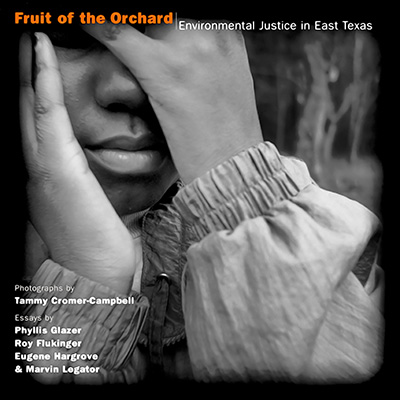
- Honorable Mention, PX3 Prix de la Photographie Paris, 2007
- 1st place, Entertainment & Culture, Green Dot Awards, 2008
September, 2006
Published
128
Pages
50 duotone illus.
Features
Ideal for Classrooms
About Cromer-Campbell's Fruit of the Orchard
In 1982, a toxic waste facility opened in the Piney Woods in Winona, Texas. The residents were told that the company would plant fruit trees on the land left over from its ostensible salt-water injection well. Soon after the plant opened, however, residents started noticing huge orange clouds rising from the facility and an increase in rates of cancer and birth defects in both humans and animals. The company dismissed their concerns, and confusion about what chemicals it accepted made investigations difficult.
Outraged by what she saw, Phyllis Glazer founded Mothers Organized to Stop Environmental Sins (MOSES) and worked tirelessly to publicize the problems in Winona. The story was featured in People, the Houston Chronicle magazine, and The Dallas Observer. The plant finally closed in 1998, citing the negative publicity generated by the group.
This book originated in 1994 when Cromer-Campbell was asked by Phyllis Glazer to produce a photograph for a poster about the campaign. She was so touched by the people in the town that she set out to document their stories. Using a plastic Holga camera, she created hauntingly distorted images that are both works of art and testaments to the damage inflicted on the people of a small Texas town by one company’s greed.
In the accompanying essays, Phyllis Glazer describes the history of Winona and the fight against the facility; Roy Flukinger discusses Cromer-Campbell’s striking photographic technique; Eugene Hargrove explores issues of environmental justice; and Marvin Legator elaborates on how industry and government discourage victims of chemical exposure from seeking or obtaining relief.
“In the finest tradition of the best documentary photographers, Tammy Cromer-Campbell has fashioned a moving portrait of the lives destroyed in a small East Texas town by industrial pollution, and in so doing has helped remake the lives of some of its poorest citizens.” —Hank O’Neal, photographer
“The photographs and accompanying text are a powerful example of environmental rhetoric, one that highlights the importance of visual imagery and cultural activism in the struggle for environmental justice.” —John W. Delicath, U.S. Government Accountability Office
Classroom Adoption
Fruit of the Orchard: Environmental Justice in East Texas is a recommended text for use in classrooms where the following subjects are being studied: Environmental Studies.
This is the story of how a toxic waste facility affected the citizens of Winona, Texas. Soon after the plant opened nearby, residents started noticing huge orange clouds rising from the facility and an increase in rates of cancer and birth defects in both humans and animals. One resident, Phyllis Glazer, was outraged and organized a grass-roots movement to publicize the problems in Winona, which resulted in the plant’s closure in 1998. During this time, Tammy Cromer-Campbell was on the scene documenting Winona’s story. Using a plastic Holga camera, she created hauntingly distorted images, fifty of which are included in this volume, that are both works of art and testaments to the damage inflicted on the people of a small Texas town by one company’s greed.
Adopted By
[“Texas A&M University for Geography 430 "Environmental Justice"”]
About the Author
TAMMY CROMER-CAMPBELL is a photographer based in Longview, Texas, whose photographs have been featured in Foto Mundo, CameraArts, and on CNN.
Buy Now
Fruit of the Orchard: Environmental Justice in East Texas
128 pp. 50 duotone illus.